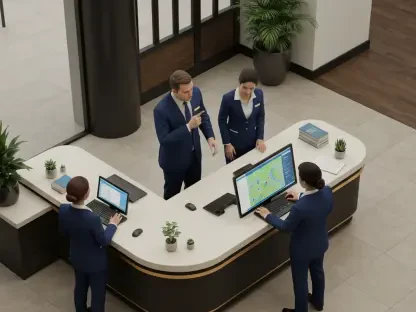Listen to the Article
After years of economic uncertainty and a lengthy pandemic that put the entire landscape of hospitality at risk, the sector is finally on the path to recovery.
But now, industry professionals are experiencing another big pain point that’s not as easy to overcome as many would like it to be: a looming recession, which makes it even more challenging to reach ideal profitability levels—and do it while balancing peak performance with cost-efficiency.
In fact, 2025 has brought a large area of headaches and points of frustration for business-decision makers, from global disruptions to inflationary pressures, technological advancements, labor shortages, and changing customer expectations.
So, what’s your key to adapting? Knowing the exact changes you should make as a manager, understanding why you need a data-driven approach to limit costs, and understanding the must-haves for some seamless guest or consumer experiences.
What’s the Role of Smart Technology in Becoming Cost-Efficient—and Are You Prepared to Use It?
The entirety of the hospitality industry knows it: reducing expenses isn’t an easy thing to do, especially when you don’t know where to get started.
Modern technologies can help. But if you’re operating on a complicated, legacy, and manual or paper-based infrastructure, it’s hard to pinpoint the best opportunities for improvements. And in a time of tightening budgets, how can you even justify substantial technology investments to business leaders?
Thankfully, there are some smart solutions on the market that’ll benefit your entire structure and change the game for hotel operations.
Artificial intelligence and machine learning have evolved beyond simple check-in kiosks. Now, they’re top tooling choices (and vital points of information) for analyzing occupancy trends, predicting demand surges, and maintaining optimal staffing levels. They can also help you assess energy usage patterns, keep inventory full without wasted resources, and make data-driven decisions that will directly lead to cost reductions in the long run.
Many of your peers are already positioning themselves as pioneers in using the technology—adopting innovations such as AI-powered property management systems (PMS), to avoid overstaffing during low-occupancy periods and remain prepared for the peak times of tourism seasons.
Another spot where intelligent technology can benefit your operations is in administrative tasks. Often lengthy, manual, repetitive (and, even worse, paper-based), these day-to-day processes can be easily simplified by investing in robotic process automation (RPA). There’s no catch in using it and for future-focused managers, it’s the key to not only improving invoice processing, inventory management, and payroll—but also cutting down on labor costs and reducing your admin teams.
While there’s a growth in expenses associated with the initial investment, the ROI is worth the digital transformation journey. By focusing on innovation and becoming digitally-driven, you’ll speed up the customer journey, boost satisfaction rates, decrease errors associated with sensitive and data-focused operations, and reduce your dependency on a human staff—in the context of ongoing labor shortages and expanding employee expectations.
What’s the Path Forward for Cost-Efficient Labor Scheduling and Labor Productivity?
Even in 2025, labor continues to be one of the largest expenses associated with the hospitality industry; and for a good reason.
With the sector being one often hindered by high turnover rates, economic uncertainties, and changing staff expectations, it’s hard to optimize Human Resources (HR) and make sure that, regardless of external factors, your teams can always perform at their best.
That’s why traditional scheduling practices and tools no longer make the efficiency cut. These often rely on human intuition, which makes it almost impossible to fully predict industry changes, regardless of how experienced a manager might be.
Today, the era of dynamic labor schedule tools and workforce analytics is starting, built to accurately forecast occupancy or guest behavior patterns and giving teams a better outlook on how they can move forward with their operations. It’s your key to eliminating unnecessary staffing costs, maintaining peak guest satisfactions, and always scheduling the right number of employees—at the right time.
The benefits don’t stop here. Adoption smarter HR-focused technologies for hospitality will position you to enable cross-training (which reduces the impact of high turnover levels), implementing the right performance-based incentives rather than fixed wages to control wage inflation, and make sure that your interest align with those of your employees (while managing payroll growth in a sustainable and future-focused way).
Ready for Strategic Revenue Management and Dynamic Pricing?
Even in times of peak economic growth, balancing what your customers want with the necessary costs for profitability is a hurdle.
Trying to keep your revenue streams on the right path amid uncertainty, an emerging recession, and global disruptions? The challenge grows tenfold.
The solution is simpler than you might think: using advanced revenue management systems (RMS), integrated with artificial intelligence and big data, to fine-tune your pricing strategies in real time and with ease.
These dynamic pricing strategies, borrowed from the airline industry, are more mature than ever—and ready for your hospitality enterprise to leverage. They analyze vast amounts of data (from competitor rates to booking trends) to set the optimal prices for every room, from one day to the next. They allow you to charge the right price to the right customer at the right time, thus maximizing occupancy and revenue per available room, indirectly reducing the per-unit cost of fixed expenditures.
Beyond room rates, auxiliary revenue streams can also be enhanced to improve the cost ratios. Personalized upsells (such as late check-outs, room upgrades, bundles experiences), through channels enabled by digital platforms, empower hotels and hospitality companies to increase the average guest spend—with only minimal budget expenses, reduction in marketing waste, and heavy contributions to top-line growth.
Final Thoughts and Steps for the Future
As hospitality continues to constantly shift and adapt in order to match economic changes and global disruptions, one thing is clear: cost management isn’t just about cutting short-term expenses—it’s about making smarter, more strategic decisions that’ll keep your business ahead, allow you to innovate, and help you meet growing customer and employee needs alike.
From embracing AI-driven tools and automating routine tasks to refining your labor scheduling and mastering dynamic pricing, the future belongs to hospitality leaders who are willing to invest in technology and use it for their benefit.
While the challenges may be complex—economic pressures, staffing instability, rising guest expectations—the chance to thrive is there, for those willing to capitalize on it.
Now is the time to shift from reactive cost-cutting to proactive performance optimization. The tools are ready. The market is moving. The question is: are you?









